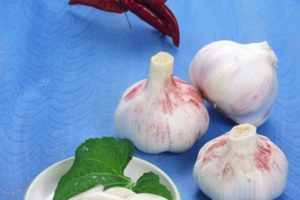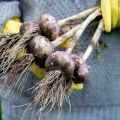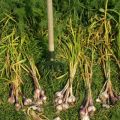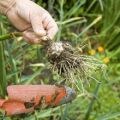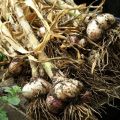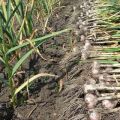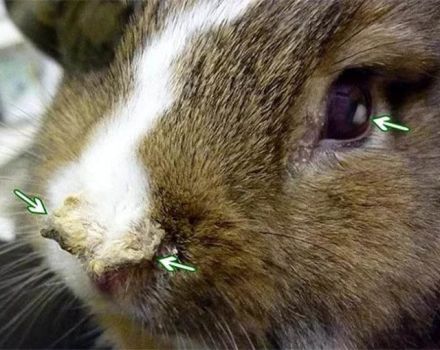When to harvest garlic in a rainy summer to save it from rot?
Garlic is one of the favorite plants of Russian summer residents. It is used in many dishes as a condiment and as a flavor enhancer. In addition, garlic has antimicrobial properties, which is important in the harsh Siberian winter. Many people use it as a means of preventing influenza and SARS. In addition, the culture is useful for other plants grown on the site, as protection from pests.
There is nothing difficult in growing garlic, it does not require a lot of labor. Therefore, knowing only the basics of gardening, you can get a good harvest. So, when to start harvesting a given crop and how to preserve it during the entire cold season.
When to dig up garlic?
If you want to get a good quality harvest of garlic, it is extremely important not to be late with the harvesting period. This is an extremely sensitive plant and a few days missing will significantly reduce the properties of the bulbs. To prevent this, you need to learn how to correctly determine the timing of harvesting garlic.
When overexposed in the ground, even for a short period, the garlic heads lose their taste, and their appearance becomes much worse. Exfoliated scales and teeth begin to disintegrate from them, this affects its keeping quality and it becomes extremely difficult to preserve it until the next sowing season.
If, on the contrary, the vegetable is dug up too early, then it will be unripe, during storage it will begin to dry out and lose its benefits.
Winter garlic harvest period starts on July 20 and ends in early August.
First of all, you need to make sure that the vegetable is ripe, the signal for this is the yellowed and lodged lower leaves. All the substances obtained by the plant are concentrated in the onions and there is absolutely no point in leaving it in the ground.
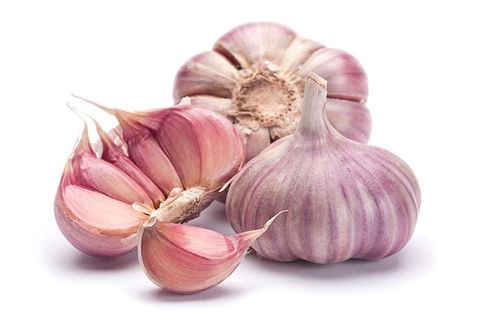
If there are some doubts, then you can dig out a couple of heads and examine. Ripe garlic should be hard, the husks should be easy to peel, and the cloves should be well separated from each other.
The second way to determine the maturity of garlic is to open the seed box at the ends of the arrows.
Don't skip this point, otherwise garlic may not survive winter storage if it rains.
When to start harvesting garlic in a rainy summer?
With winter garlic, everything is now clear, but how to determine whether it is possible to harvest a summer harvest?
Experienced gardeners start digging spring garlic about two weeks later than winter garlic. This period lasts from mid-August to mid-September.

Growing conditions significantly affect the ripening period of the garlic head.The growing season and the quality of the crop depend on the weather conditions, the variety, whether there was feeding.
The ripeness of summer garlic is determined by the leaves - the lower ones should turn yellow, the upper ones should lie down, the bulb should be firm and strong, peel well and not separate into cloves.
Based on the above signs, it is clear when to harvest garlic in a rainy summer. The ripening period under such conditions is reduced, but the signs of the signals for maturity remain the same.
How to improve the quality of the crop?
To properly harvest the crop, you need a set of preparatory measures. They begin to be made from the moment the arrows straighten - this is a signal that the onions have begun to fill. To increase the flow of nutrients to the heads, the following manipulations are performed:

- Tie the leaves in a knot (this increases the ripening time by about 2 weeks, it is not recommended to do it in rainy weather).
- Removing the soil from the bulbs will increase the access of oxygen to them, the method accelerates ripening by 3-4 days.
The harvesting of garlic depends on the weather, planting time and destination. First, they begin harvesting for canning. Later, winter and spring crops are harvested. In addition, seed heads must be harvested 5 days later than those intended for food use. A delay in harvesting, especially in a rainy summer, leads to the secondary formation of the root system and the germination of heads.
Cleaning
In order to get a high-quality harvest that can lie in the bins all winter, you need to properly harvest it. First of all, you need to stop watering a month before the procedure. You need to collect garlic on a dry sunny day, while sheltering it from sunlight.

The bulbs must be dug with a pitchfork, shaken off the ground and laid to dry in the shade. During this procedure, the leaves give the remaining nutrients to the heads. The dug garlic can be tied in bunches and hung in the sun, so the process will be faster. When it rains, it is dried in a closed, ventilated room.
How to preserve and save garlic from disease?
When all crops are removed, the question arises how best to preserve them:
- before cleaning in the basement, the heads must be completely dry;
- the storage room must be dark;
- winter varieties prefer temperatures up to plus 3 degrees, summer varieties tolerate up to plus 18 degrees.

Never place the crop in a humid environment, the air should be dry, also avoid drafts and too high a temperature, it should not exceed 20 degrees.
For garlic, enterprising summer residents have come up with many storage methods:
- braids - save space, are easily viewed in order to detect damage;
- baskets - take up little space, ventilated;
- bundles - can be used for storage in a shed or attic;
- nets - hang on the wall and save space;
- in addition, you can use boxes, boxes, linen bags;
- in a city apartment, you can save a vegetable in jars.
It is necessary to monitor the safety of the crop during the wintering period. Some difficulties may arise with it, and then you should know how to save garlic:
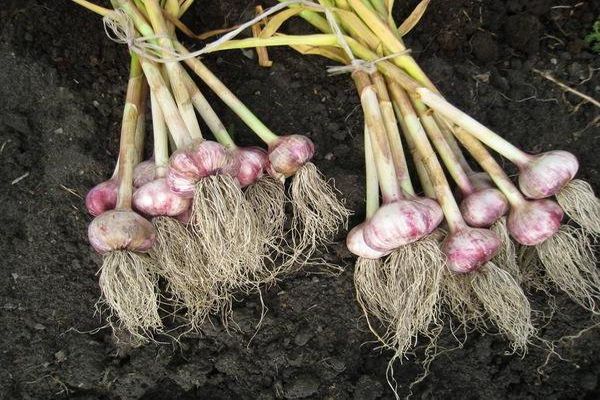
- Rot and mold appear due to high humidity, when they appear, it is necessary to remove the affected heads, and dry the rest in a warm place for a week, then place in a dry place. You can protect yourself from rot by sprinkling the onions with salt.
- Winter varieties can dry out by the end of storage; this can be delayed by wrapping them with cellophane wrap.
- The defeat of the stem nematode requires the separation of the healthy from the infected. Surviving bulbs must be treated with an insecticide, dried and stored again until next year.
- Germination, if this happens, the garlic needs to be peeled and filled with vegetable oil and stored at a temperature not exceeding 2 degrees.
The safety of the crop directly depends on the correctness of its harvest and compliance with its terms.And choosing the most convenient way of storage is everyone's personal business.
